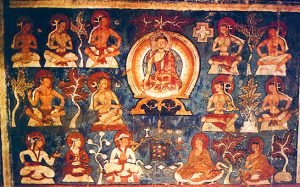 Manichaeism, a syncretic religion, was founded by the prophet Mani in the 3rd century AD. He and his predecessors were able to blend elements from Zoroastrianism, Christianity, Hinduism, and Buddhism, positing a cosmic struggle between the forces of light and darkness. Despite its initial widespread appeal and influence across the Roman Empire, the Sassanian Empire, and beyond, Manichaeism faced severe persecution from various political and religious authorities, leading to its sharp decline.
Manichaeism, a syncretic religion, was founded by the prophet Mani in the 3rd century AD. He and his predecessors were able to blend elements from Zoroastrianism, Christianity, Hinduism, and Buddhism, positing a cosmic struggle between the forces of light and darkness. Despite its initial widespread appeal and influence across the Roman Empire, the Sassanian Empire, and beyond, Manichaeism faced severe persecution from various political and religious authorities, leading to its sharp decline.
In the Middle East, particularly in regions of Iraq and Iran, small groups continue to uphold the Manichaean religion and practices. These modern adherents, though fewer than 4,000, maintain a connection to their ancient traditions, often practicing in secret due to the historical and ongoing pressures from dominant religious and political powers in the region.
It should be no surprise that Manichaeism was declared heretical by the Roman Catholic Church and persecuted within the Roman Empire. The Sassanian Empire, which initially tolerated the faith, also turned against it. The rise of Islam further marginalized Manichaeism, as Islamic rulers often viewed it with suspicion or outright hostility. Despite these challenges, Manichaeism left a lasting cultural impact. Elements of Manichaean thought influenced other religious and philosophical traditions. In regions where it survived, it often did so by integrating into local cultural contexts, adapting its practices and teachings to remain relevant and less conspicuous.
Today, Manichaean communities are small and scattered. In Iraq, the Mandaeans, a Gnostic sect with some theological parallels to Manichaeism, represent a close modern-day connection. While not directly Manichaean, they share some of the same ideas and some ritual practices reminiscent of Manichaeism.
In Iran, a few isolated Manichaean groups retain strong elements of Mani’s tradition, though they often blend these with other local religious customs. Given the historical persecution, modern Manichaeans typically practice their faith discreetly. This secrecy has been essential for their survival, allowing them to preserve their traditions while avoiding the attention of authorities or hostile neighbors. This discretion means that much of what is known about contemporary Manichaean practice comes from anecdotal reports and the efforts of scholars studying these communities. I have had the opportunity to meet and interview several Manichaeans in Turkey and Iran.
There has been a resurgence of interest in Manichaeism among scholars and cultural historians. This has led to a greater understanding of its historical impact and contemporary survival. Research into ancient Manichaean texts, art, and rituals has provided valuable insights into the religion’s enduring legacy.
Manichaeism’s continued existence is a testament to the tradition’s capacity to remain afloat in the face of adversity. The small communities that keep its teachings alive provide a living link to one of history’s most fascinating and complex faiths.